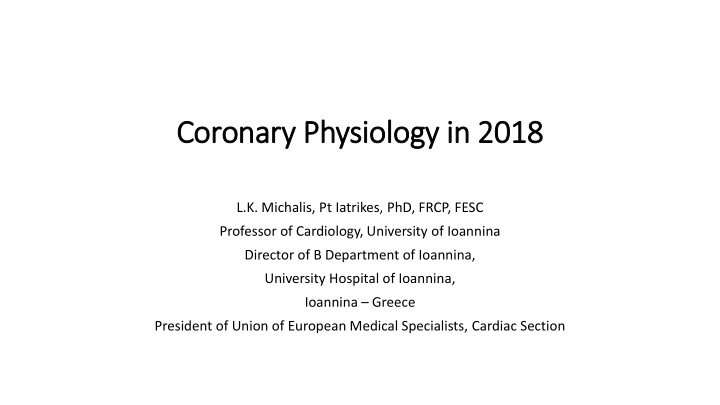



Coronary ry Physiology in 2018 L.K. Michalis, Pt Iatrikes, PhD, FRCP, FESC Professor of Cardiology, University of Ioannina Director of B Department of Ioannina, University Hospital of Ioannina, Ioannina – Greece President of Union of European Medical Specialists, Cardiac Section
FFR: 20 years ago FFR isch ischaemia ia dia iagnosis is in in th the cath th lab lab: one stop sh shop • FFR corelates well with Spect and thus can diagnose ischaemia in the cath lab. • 45 patients N Engl J Med 1996; 334:1703-1708
How thin ings have evolved afterw rwards: FFR in in SCAD Randomized stu tudies and Registr tries • Randomized studies • DEFER • FAME • FAME II • FUTURE • Prospective Registry • IRIS-FFR Clinical utility of FFR: FROM AN INDEX DIAGNOSING ISCHAEMIA IN CATH LAB AND REPLACING INTO SOME EXTEND THE UTILITY OF MYOCARDIAL FUNCTION TESTS TO A PREDICTOR OF FUTURE EVENTS
FAME II STUDY: 24 MONTHS FOLLOW-UP: Can really significant lesions (FFR<0.80) be treated with OMT only? Patients with FFR<0.80 are benefited from PCI due to less urgent ReVasc Patients with FFR>0.80 do well on OMT N Engl J Med 2014
IRIS FFR REGISTRY The largest prospective, multicenter registry of FFR “risk continuum” for FFR in deferred coronary stenoses. FFR <0.79 PCI reduces possibility of revasc FFR <=0.64, PCI reduces possiblility of death of MI FFR<0.76 reasonable to perform PCI Independent predictors of clinical events in deferred FFR, Imaging characteristics • thrombus-containing lesion, • multivessel coronary artery disease, and • percent diameter stenosis. Cicrulation 2017
FFR in SCAD • FFR can diagnose ischaemia • FFR can predict future events helping thus clinical decision making in SCAD patients Clinical use of FFR • FFR<0.80 PCI with DES reduces the risk of revasc (urgent and non) • In patients with MVD we can decide which artery should be treated based upon FFR (<0.80) • FFR<0.64 PCI with DES reduces the risk of death or MI
Use of FFR in the everyday clinical practice • FFR in <20% of the selective PCIs • Possible reasons • Financial cost ( • Prolongation of the procedure • Adenosine administration (cost and side effects) • Alternative to FFR methodologies • BASED UPON PHYSIOLOGY • iFR • STAND ALONE IMAGING • Coronary angiography • IVUS (virtual histology) • OCT • IMAGING COUPLED WITH PHYSIOLOGY • FFRct • vFAI • ESS
iFR: Index with similar to FFR philosophy BUT without the need of adenosine • Deferral of revascularization is equally safe with both iFR and FFR • 1 year MACE rate of deferred lesions around 4% • 1 year MACE rate of deferred lesions higher in ACS compared to SCA pts (5.91% vs 3.64%) • Advantages of iFR vs FFR • No need of adenosine • Cost • Side effects • ? Better accuracy in predicting severity of tandem lesions
Stand alone imaging • IVUS and Virtual Histology • OCT • 3D coronary angiogram
PROSPECT STUDY TCFA PROSPECT STUDY – 3yr MACE VIVA-VH STUDY – 2yr MACE Stone GW et al. N Engl J Med 2011
Recommend
More recommend